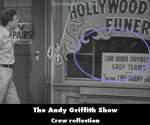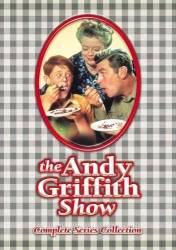
Mayberry Goes Hollywood - S1-E13
Visible crew/equipment: When Andy sees that several stores have made 'Hollywood' changes and then walks past the two men wearing suits, it cuts to Andy walking up to 'Hollywood funerals' and we can see the reflection of a crew member pushing the camera dolly with other crew members.
Mayberry Goes Hollywood - S1-E13
Visible crew/equipment: Before the producer's arrival in his car, when Barney's telling Andy that it'll serve him right if they don't put him in the picture because Andy's not wearing his new uniform, we can see the moving shadow of the boom's hinge and mic on Andy's shirt.
Mayberry Goes Hollywood - S1-E13
Visible crew/equipment: Near the end, after the producer tells the townspeople to get back to normal and out of their trick or treat outfits, when the crowd disperses we can see some curved chalk lines on the ground near the producer's feet, to mark actors' positions.







Answer: As noted in the previous answers, in real life, things like this provided wind and/or rain deflection, and also maintained a bit of privacy when blinds were raised somewhat. The interior courthouse set was located in the studio, so the "outside" Main Street didn't exist. I believe these things were added to the courthouse windows for practicality, to avoid some crew movement being visible on the opposite side of those windows. These are not "window boxes" to hold anything, as they're actually bottomless; we can see the Venetian blind's long pull cords under them. They're made of plywood and simple to build, so the "material and labor" was inexpensive. Similar variations made of different materials are in other movies/shows. In 1957's "12 Angry Men," textured chicken wire glass panels are in the jury room windows, and in "Jesse Stone: Night Passage" another type is in Jesse's office windows.
Super Grover ★